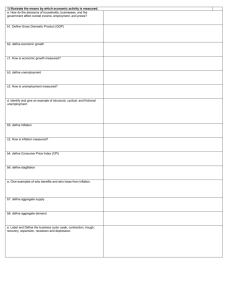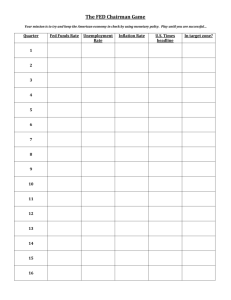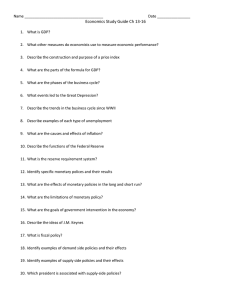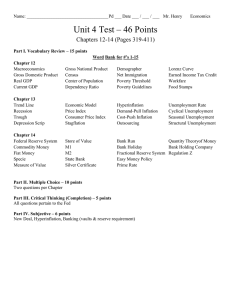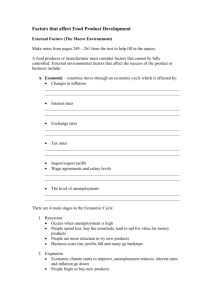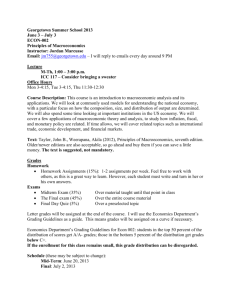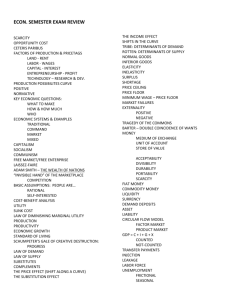COURSE TITLE: Principles of Macroeconomics COURSE NUMBER:
advertisement
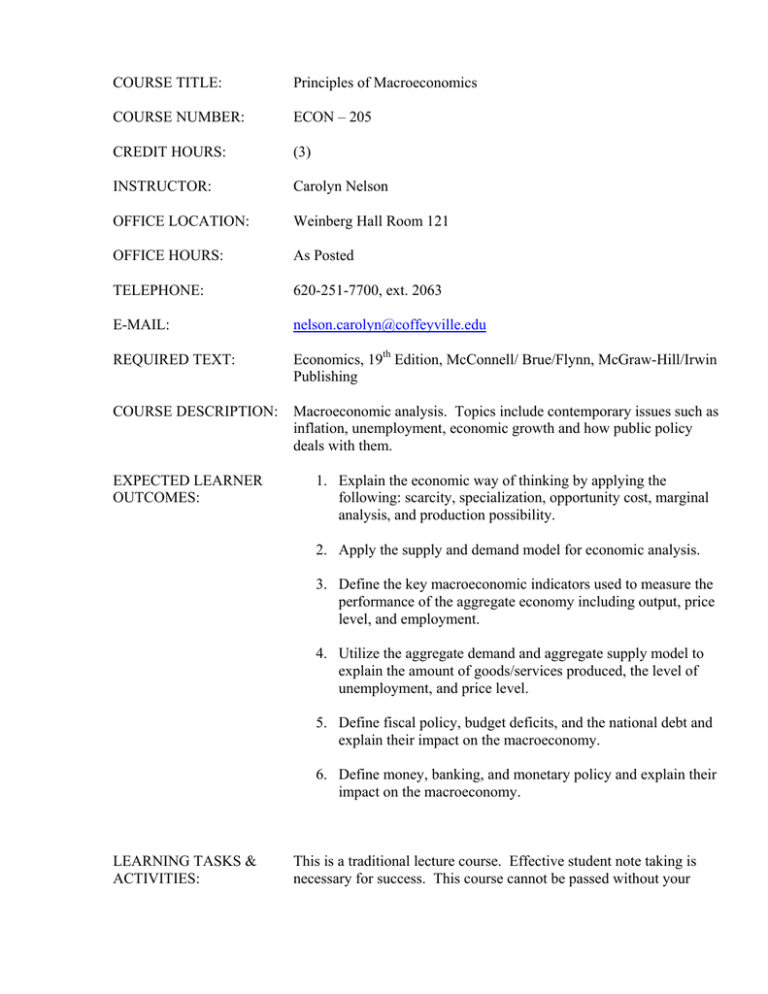
COURSE TITLE: Principles of Macroeconomics COURSE NUMBER: ECON – 205 CREDIT HOURS: (3) INSTRUCTOR: Carolyn Nelson OFFICE LOCATION: Weinberg Hall Room 121 OFFICE HOURS: As Posted TELEPHONE: 620-251-7700, ext. 2063 E-MAIL: nelson.carolyn@coffeyville.edu REQUIRED TEXT: Economics, 19th Edition, McConnell/ Brue/Flynn, McGraw-Hill/Irwin Publishing COURSE DESCRIPTION: Macroeconomic analysis. Topics include contemporary issues such as inflation, unemployment, economic growth and how public policy deals with them. EXPECTED LEARNER OUTCOMES: 1. Explain the economic way of thinking by applying the following: scarcity, specialization, opportunity cost, marginal analysis, and production possibility. 2. Apply the supply and demand model for economic analysis. 3. Define the key macroeconomic indicators used to measure the performance of the aggregate economy including output, price level, and employment. 4. Utilize the aggregate demand and aggregate supply model to explain the amount of goods/services produced, the level of unemployment, and price level. 5. Define fiscal policy, budget deficits, and the national debt and explain their impact on the macroeconomy. 6. Define money, banking, and monetary policy and explain their impact on the macroeconomy. LEARNING TASKS & ACTIVITIES: This is a traditional lecture course. Effective student note taking is necessary for success. This course cannot be passed without your doing the assigned reading. Exams are based on the text, classroom lectures, and handouts. ASSESSMENT OF OUTCOMES: ATTENDANCE is important, because class concepts build on each other. ABSENCES: Regular attendance is expected. Any student who has 7 unexcused absences will be dropped from the class for excessive absences and non-participation in the class. Refer to College catalog – “Withdrawal from Classes for Non-Attendance/NonParticipation”. College sponsored events will be counted as excused absences provided students complete all necessary assignments as designated by the instructor. Excused absences are to include academic competition, judging team competition, music events, official athletic events, field trips, and other College-sponsored events as approved by the Vice President for Learning. TARDY: You are counted tardy anytime that you come in after the attendance has been taken. Three tardies make an unexcused absence. ELECTRONICS: Cell phones, iPods, and/or any other electronic devices are not allowed to be turned on during class time and should be out of sight. If you are caught using one of these devices you will be counted an unexcused absence for the class. SLEEPING: You must be more that just physically present in class. You must pay attention—not talking to your neighbor, appearing to sleep, or doing work not related to this class. You must bring to class and use the assigned text. Uncooperative students will be dismissed from class for the day and counted as an unexcused absence. Be courteous to the class. If lecture has started and the door is closed, do not stand at the door and knock. Consider yourself absent for the class. You will be counted absent. If the door is still open, come in quietly. You will be counted tardy. Once class begins, you cannot get up and leave without specific permission from the instructor. If you have to leave without permission, do not return. You will be counted absent. Be respectful to yourself, your classmates and your instructor. We can all work towards a good semester. DAILY WORK will be assigned and students will be held responsible for completion. Students should come to class prepared to discuss exercises and problems. CLASSROOM EXPERIMENTS are demonstrations worked in class to emphasize a subject. EXAMS use conceptual questions to test the student’s comprehension and application of economic concepts. While there is some new vocabulary to master, the emphasis of the course is on analytical thinking and conceptual understanding. The exam format will be multiple choice questions. GRADES will be based on the following: Daily Work 35% Classroom Experiments 15% Major Exams 40% Final 10% Total 100% Grade A B C D F Additional Information: Percentage 100 – 90% 89 – 80% 79 – 70% 69 – 60% 59 - 0 % Disabilities that require any accommodation or other assistance should make an appointment to speak with me as soon as possible. Academic Honesty: Each student is to do his or her own work. Appropriate action will be taken on any student who is found borrowing another student’s work: this may include receiving a failing grade, being dropped from the class or being placed on academic probation. THIS SYLLABUS IS SUBJECT TO REVISION WITH PRIOR NOTICE TO THE STUDENT BY THE INSTRUCTOR. PRINCIPLES OF MACROECONOMICS COMPETENCIES I. ECONOMIC HISTORY DISCUSS THE AMERICAN ECONOMY FROM THE 19TH CENTURY THRU THE NEW MILLENNIUM 1. Define the agricultural economy. 2. Discuss the Great Depression and policies that brought America out of it. 3. Discuss presidential economic policies. II. MACROECONOMIC FOUNDATIONS DISCUSS RESOURCE UTILIZATION 4. Define scarcity and opportunity cost. 5. Graph production possibility curve. DEFINE AND GRAPH SUPPLY AND DEMAND 6. Define supply and discuss the affect of price changes. 7. Define demand and discuss the affect of price changes. 8. Determine what equilibrium means. IDENTIFY AND DISCUSS MIXED ECONOMIES 9. Discuss characteristics of the market system. 10. Identify the five fundamental questions that should be asked. 11. Define and demonstrate the “invisible hand”. 12. Discuss the Circular Flow Model. III. GROSS DOMESTIC PRODUCT DISCUSS THE HOUSEHOLD-CONSUMPTION FACTOR INCLUDING PROPENSITY TO CONSUME AND PROPENSITY TO SAVE 13. Analyze consumer spending versus consumer saving. 14. Discuss the multiplier effect and calculate spending levels. DEFINE THE BUSINESS-INVESTMENT SECTOR 15. Discuss legal forms of business. 16. Revisit the Circular Flow Model. IDENTIFY THE GOVERNMENT SECTOR INCLUDING TYPES OF TAXES AND THE REDISTRIBUTION OF INCOME. 17. Discuss transfer payments and government spending. 18. Define types of taxes. DISCUSS THE EXPORT-IMPORT FACTOR INCLUDING WORLD TRADE AGREEMENTS 19. Discuss America’s role in World Trade. 20. Define specialization and comparative advantage. 21. Discuss Free Trade Zones. IV. UNEMPLOYMENT AND INFLATION COMPUTE THE UNEMPLOYMENT RATE. 22. Calculate the unemployment rate given the definition of unemployment. DEFINE TYPES OF UNEMPLOYMENT 23. Discuss the discouraged worker. 24. Determine what is necessary to classify a worker as unemployed. DEFINE INFLATION . 25. Determine what factors can be changed to lower this rate. 26. Discuss who is affected by inflation. 27. Determine the affect inflation has on output. DISCUSS THE CONSUMER PRICE INDEX 28. Define the consumer price index and discuss who keeps this index. 29. Review the index over a period of time. . V. FISCAL POLICY AND THE PUBLIC DEBT DISCUSS THE MULTIPLIER AND ITS APPLICATIONS. 30. Discuss government spending and the affect on the economy. 31. Evaluate fiscal policy by applying the multiplier. 32. Model expansionary fiscal policy to contractionary fiscal policy. CONTRAST THE PUBLIC DEBT TO THE PUBLIC DEFICIT. 33. Define the public debt versus the public deficit. DEFINE THE DEFICIT DILEMMA 34. Discuss ownership of the public debt. VI. THE FEDERAL RESERVE AND MONETARY POLICY DEFINE THE FEDERAL RESERVE SYSTEM. 35. Discuss the Federal Reserve System 36. Define when it was established and why. DISCUSS THE TOOLS OF MONETARY POLICY INCLUDING THE DISCOUNT RATE AND RESERVE REQUIREMENTS 37. Discuss monetary policy and what tools are required are used to expand or contract the money supply. 38. Define the discount rate and how it is used. 39. Discuss reserve requirements and how they are used. IDENTIFY THE MONETARY CONTROL ACT OF 1980 AND THE BANKING ACT OF 1999 40. Discuss legislation that has changed banking in the United States.
